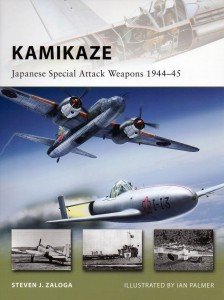 By Steven J. Zaloga, Osprey Publishing, Oxford, UK, (2011)
By Steven J. Zaloga, Osprey Publishing, Oxford, UK, (2011)
Reviewed by Rear Admiral Ed Keats, U.S. Navy (Retired)
In 1944, the Japanese high command realized they had been defeated in the war against the United States. Their efforts then concentrated on procuring the best post-war terms they could gain. They believed the optimum way was to inflict enough major losses in terms of personnel and material on the United States to induce an end to the war without the requirement of an unconditional surrender. The method they chose was to employ much of their remaining assets in suicide attacks on American ships. They added to their existing resources those they could quickly build in small yet undamaged sites. As it turned out, small airplanes became the preferred means because they were more successful than small surface or underwater boats. The campaign commenced in a limited way in their struggle to hold on to the Philippines in 1944 and in the defense of Iwo Jima in early 1945. Suicide attack reached its peak in the battle for Okinawa in mid-1945.
Kamikaze by Steven J. Zaloga and published by Osprey of Oxford, England, a firm that specializes in illustrated books on the history of warfare, expertly recounts the story of Japanese suicide planes, known to the U.S. as “Kamikaze” (in Japanese, ‘Divine Wind’) but referred to as “Tokko” by the Japanese. Tokko means “special attack” in their language. The emperor, Zaloga says, preferred not to recognize that his forces would engage in suicide attack. There is, perhaps to the Japanese, a philosophical difference between a suicide attack on an enemy and defeated military officers taking their own lives.
Zaloga’s book provides a description of the tactics of suicide pilots which were to fly into American ships to create damage by explosion of the bomb they were carrying or, at least, by the impact and fire from their own gasoline. He emphasizes and offers details of how the suicide conveyances were constructed. His account covers not only airplanes but also ship and submarine suicide craft. They were built but not successfully employed and thus have escaped becoming general knowledge. He is thorough and, almost always correct in his account.
I say, “almost” because of his statement, “Destroyer and destroyer escorts were used [by the US] to establish picket lines around carrier task forces, serving both to extend the radar early-warning network and create a first line of defense against the kamikazes.” No picket line could keep up with the fast carrier task force and no anti-kamikaze picket line was ever formed around the task force.
At the time of the kamikaze threat, I was Air Officer for Commander Amphibious Force, Pacific. At a meeting of principal officers of the staff, I said, “At altitude even an experienced pilot has difficulty distinguishing between a cruiser and a destroyer or a destroyer from a gunboat. The inexperienced suicide pilots will be even more confused. They will be tempted to attack the first possible target they encounter.”
The Amphibious Force then established fifteen points between the landing beaches at Okinawa and the Japanese homeland and ordered one destroyer plus four Landing Craft, Infantry (LCI) ships to circle each point. An imaginative member of the staff came up with the appellation, “Radar Picket Ships” but they were not radar sentries, rather they were live targets somewhat similar to the wooden decoys often used by hunters of waterfowl. They were just sitting targets, waiting for attackers. Although they attempted to protect themselves with gunfire, they absorbed significant damage, leading to some sinkings but many casualties. Overall, and much to their credit, their sacrifice was important in protecting the vessels unloading over the Okinawa beaches.
It is revealing to learn from Zaloga of the vibrancy the Japanese were able to retain in their manufacturing capability despite continual bombing by carrier planes and large Army Air Force bombers. Although the efficacy of bombing has been widely promoted by air warfare enthusiasts, the ability of the Japanese to produce kamikaze weapons after suffering from many attacks provides a telling counter argument to such assertions.
Zaloga performed extensive research at the National Archives and Research Administration located at College Pak, Maryland to select the revealing photographs of the construction of kamikaze weapons displayed in his book. Although the material remains available to others, it is unlikely that anyone will desire to repeat his work. This may be, therefore, the final reference book on Japanese suicide weapons in World War II. Since Zaloga leaves little left undocumented, “Kamikaze” is now and will be in the future the essential reference for those interested in that facet of the final battles in the Pacific war.
Rear Admiral Edgar Keats, a graduate of the U.S. Naval Academy Class of 1935, is a frequent contributor to Naval History Book Reviews.

